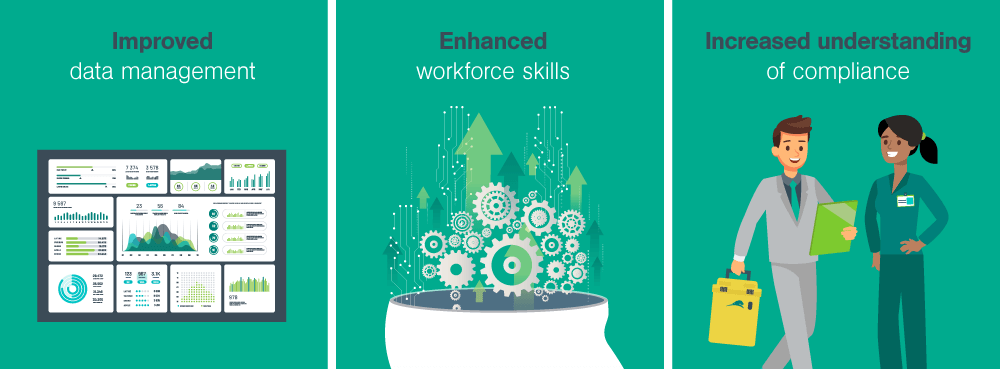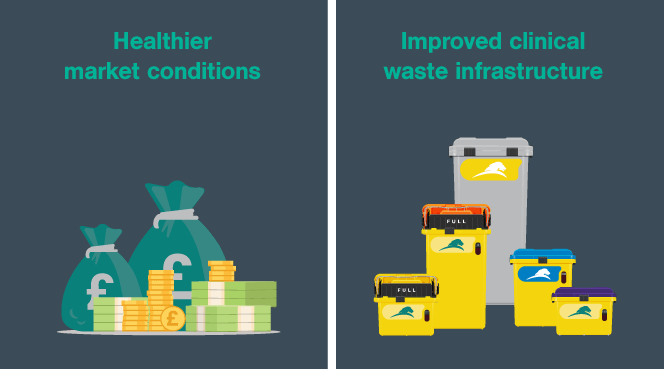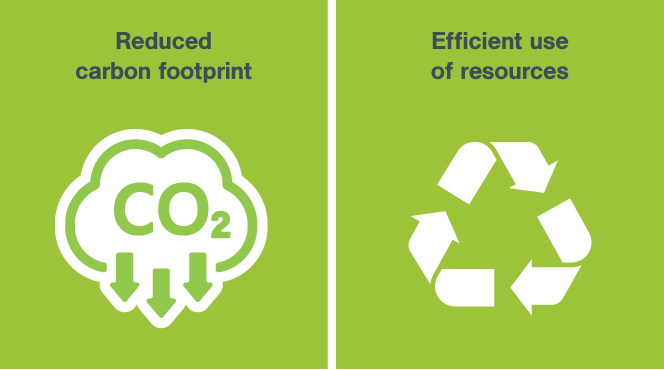The Key Themes and Targets of the NHS Clinical Waste Strategy

Did you know that the NHS produces a staggering 156,000 tonnes of clinical waste every year? As well as having a significant environmental impact, this volume of waste also comes with a hefty financial burden. To revamp its waste management process and tackle the challenges associated with healthcare waste, the NHS has developed a Clinical Waste Strategy. It’s been designed to help NHS providers reduce waste volumes and eliminate overtreatment whilst improving compliance – and to save money whilst minimising environmental burden.
When it comes to healthcare and clinical waste, we take pride in knowing a thing or two on the subject and we’re HUGE advocates of this wonderful new strategy! In this blog, we’ll be digging into the key themes and targets of the NHS Clinical Waste Strategy as outlined within the main document and its appendices.
TOPICS WE WILL COVER:
1 / The key themes of the NHS Clinical Waste Strategy
2 / Key theme one: Productivity
4 / Key theme three: Net Zero Carbon
5 / The targets of the NHS Clinical Waste Strategy
6 / Are you looking for support to execute the Clinical Waste Strategy?
The Key Themes of the NHS Clinical Waste Strategy
The NHS Clinical Waste Strategy is made up of three key themes and six related areas that sit within those themes. The key themes and their related areas are:
- Productivity: Data, Workforce, and Compliance.
-
Resilience: Commercial, and Infrastructure.
-
Net Zero Carbon: Sustainability.
Let’s dive into each of the key themes and their related areas to look at the strategic priorities and measures of success to gain a better understanding of the strategy as a whole.
Key Theme One: Productivity
Increasing productivity within clinical waste management is the focus of the first key review theme. This involves implementing more effective systems and training to improve data management, enhancing workforce skills, and improving overall staff understanding of compliance.

Data
Strategic priority: To make informed decisions and effectively manage potential risks, it’s crucial to rely on comprehensive and consistent data collected from all NHS organisations and Integrated Care Systems (ICSs). Using better and more accurate data enables enhanced decision-making processes and a proactive approach to risk management.
Measure of success: All clinical waste generated by NHS providers is regularly reported with a minimum of 95% accuracy by 2024.
Review findings: Hospitals across the UK have traditionally reported their waste information annually through the Estates Returns Information Collect (ERIC), but this data tends to be outdated and imprecise by the time it’s published. fact, when the data for the 2019-20 financial year was analysed, it was discovered that over 100 Trusts and Foundations were found to have made errors in their reporting, resulting in inaccurate information about waste volumes, classifications, and costs.
The COVID-19 pandemic emphasised the need for precise, real-time waste management data to respond to sudden changes in waste generation and treatment demands throughout the country. The current approach to capturing waste data in the NHS makes it hard to assess the effectiveness of waste management strategies and their environmental impact – It also makes it hard to analyse the data and make informed decisions for the future. All in all, this highlights the significance of enhancing the quality of waste-related data submitted to ERIC by conducting more frequent and rigorous checks.
Workforce
Strategic priority: To develop a skilled and diverse team in waste management, providing them with the necessary support and defined career paths to ensure the right people are in place to overcome any challenges that may arise. This investment in a skilled workforce benefits the organisation as well as the employees who are able to grow professionally and achieve their career goals.
Measure of success: 100% of NHS Trusts and Foundation Trusts to have a dedicated Waste Manager by 2023, funded from their own resources. 100% of other NHS providers to have identified accountable individuals for waste management.
Review findings: Whilst waste management may not be the most exciting topic, it’s a crucial aspect of providing quality healthcare. Everyone in the NHS from patients to staff members generates clinical and offensive waste within the healthcare environment, which is why it’s essential to understand how to manage it effectively. Unfortunately, the majority of NHS workers receive no waste management training which means they may not know how to safely dispose of waste.
By addressing this training gap with the provision of waste management training and the implementation of the updated Health Technical Memorandum (HTM) 07-01: Safe and Sustainable Waste Management for Health and Social Care, NHS staff can be empowered to make informed decisions about waste management. Some NHS settings have Waste Managers in place to oversee processes but others lack dedicated personnel for this role. It’s important to establish clear roles and responsibilities and allocate the necessary resources to oversee waste-related activities to ensure consistent and cost-effective waste management across all NHS providers.
Compliance
Strategic priority: To ensure all NHS staff have a solid understanding of regulatory requirements to improve their ability to comply. An improved understanding of compliance and best practices will enable staff to segregate correctly and manage waste effectively.
Measure of success: NHS providers achieve clinical waste segregation targets of 20:20:60 by 2026.
- 20% HTI (High-Temperature Incineration);
- 20% AT (Alternative Treatment);
-
60% OW (Offensive Waste).
Review findings: It’s crucial to categorise clinical waste based on its hazardous properties and associated treatment method and the most effective way to do so is by classifying and segregating the waste at the point of production. The updated HTM 07-01 provides helpful guidance on the correct approach to waste classification and segregation, outlining the necessary measures for maintaining compliance. To ensure a more environmentally friendly approach to waste disposal, this guidance must be applied across the NHS regardless of the organisation or site’s size or scale.
Maintaining comprehensive records of all waste movements is also essential to monitor the effectiveness of waste management practices and whether it’s being sent for the most appropriate treatment. Raising awareness of compliance requirements among all NHS staff is crucial, especially among those responsible for waste management.
Key Theme Two: Resilience
The need to enhance the resilience of clinical waste management within the NHS is the focus of the second key review theme. The importance of improving resilience in waste management and treatment became apparent due to the significant increase of around 300% in clinical waste tonnages during the COVID-19 pandemic. This created substantial pressure throughout the healthcare system and was emphasised by the challenges related to infrastructure and capacity.

Commercial
Strategic priority: To establish a commercial model that delivers better value and encourages healthier market conditions by supporting the standardisation of contracting arrangements. This will help to promote fair competition, encourage innovation, and enhance the quality of services provided.
Measure of success: The average net cost of clinical waste management reduces by 15% per tonne of waste by 2030 (after inflation and/or above increased treatment costs).
Review findings: There are currently four large waste management providers dominating the market for clinical waste handling and processing who manage more than 85% of the total NHS clinical waste tonnage. The result is a limited network of processing infrastructure and increasing costs due to high demand – greater transparency is needed between waste-producing and waste-management organisations to address this issue. If action isn’t taken to reduce waste volumes, the cost of managing clinical and offensive waste could increase up to three times the current cost by 2029/30.
A framework of standards for service providers is needed to address the inefficiencies caused by inconsistent approaches to outsourcing. A standardised approach to clinical waste contracting will increase the visibility of outsourcing arrangements and improve the consistency, quality, and value of the service being provided.
Infrastructure
Strategic priority: To invest in and develop resilient clinical waste infrastructure that increases capacity, supports sustainable waste processing practices, and is able to meet future demand. This will nurture confidence in the ability to provide a safe and reliable service whilst also contributing to a healthier environment.
Measure of success: All NHS providers introduce arrangements for the management of the offensive waste stream by 2023.
Review findings: The infrastructure used plays a large part in the safe and efficient processing of the clinical waste generated by the NHS – some older infrastructure isn’t operating within permitted limits and this often leads to costly refurbishments to keep waste processing facilities operational. The current infrastructure network isn’t well-matched to the present and future needs of the NHS and existing facilities aren’t incentivised to upgrade to meet those needs.
The benefits of reducing the reliance on third-party infrastructure for waste treatment and increasing onsite processing capacity include self-sufficiency and improved geographic distribution of processing capacity, reducing the need for long-distance transportation of waste.
Overall, the findings demonstrate the need to consider onsite waste treatment when developing plans for new hospitals.
Key Theme Three: Net Zero Carbon
The third and final key review theme focuses on the NHS’s commitment to becoming a greener organisation and reaching net zero carbon emissions. As well as tackling the carbon emissions it directly controls, the NHS is also looking to reduce the emissions it can influence.
To reach its goal, the NHS has set two objectives:
- For emissions the NHS directly controls: Reach net zero by 2040, with an ambition to reach an 80% reduction by 2028 to 2032.
- For emissions the NHS can influence: Reach net zero by 2045, with an ambition to reach an 80% reduction by 2036 to 2039.

Sustainability
Strategic priority: To proactively reduce carbon impact and improve the use of resources; promoting sustainable practices to protect the environment, improve local air quality, and reach the 2045 net zero target.
Measure of success: Achieve a 50% reduction in the carbon emissions produced from waste management by 2026, and an 80% reduction by 2028-32.
Review findings: With NHS Trusts and Foundations currently producing around 377,000 tonnes of waste every year, the reduction of the carbon emissions and environmental impact that results from clinical waste has become a key focus of the Clinical Waste Strategy. It’s clear that there’s a need for change in both thinking and behaviour when it comes to waste management to significantly reduce the high output of associated carbon emissions – the waste hierarchy highlights the importance of prioritising waste reduction and reuse when making decisions related to waste management.
Waste management contracts will be expected to include detailed and realistic CO2e reduction strategies such as waste reduction, reduced road miles, increased onsite waste treatment, and diversion from landfill. Waste Managers will also be expected to work closely across all NHS departments including procurement and purchasing to eliminate and reduce single-use items and packaging wherever possible, whilst increasing reuse.
The Targets of the NHS Clinical Waste Strategy
Using the measures of success taken from the key themes, their related areas and strategic priorities, the NHS has developed a chronological timeline of its Clinical Waste Strategy that holds the measures of success to target dates.
- 2023: (Workforce) 100% of NHS trusts and foundation trusts have dedicated Waste Managers (at least 0.5 FTE) with accountable individuals for waste management identified across all providers.
- 2023: (Infrastructure) All NHS providers introduce arrangements for the management of the offensive waste stream.
- 2024: (Data) All clinical waste generated by NHS providers is regularly reported with a minimum of 95% accuracy.
- 2026: (Sustainability) 50% reduction in carbon emissions produced from waste management in NHS organisations (leads to 80% reduction in carbon emissions by 2028).
- 2026: (Compliance) All NHS providers achieve clinical waste segregation targets of 20:20:60 HTI (High-Temperature Incineration), AT (Alternative Treatment), and OW (Offensive Waste).
-
2030: (Commercial) The average net cost of clinical waste management reduces by 15% per tonne of waste.
We’re excited to see how the next few years unfold and the effect of this Clinical Waste Strategy as its implemented and upheld across the NHS.
Are You Looking for Support to Execute the Clinical Waste Strategy?
We’re here to help! At Sharpsmart, we’re no strangers to developing and implementing bespoke waste management strategies designed to help Hospital Trusts and Foundations reduce waste volumes, comply with legislation, and reach sustainability benchmarks. We’re much more than just a waste management service and our work doesn’t end at the loading dock – our expert waste consultants work with your teams inside the four walls of your organisation. Please don’t hesitate to get in touch.
